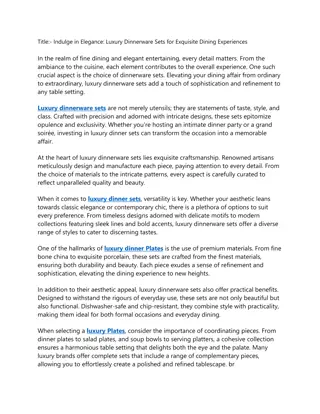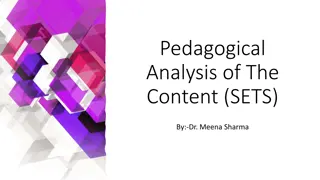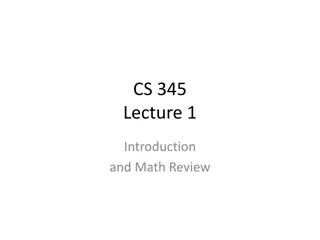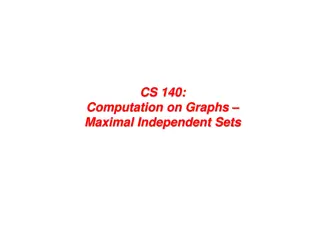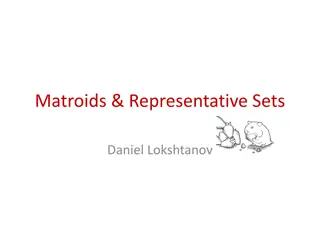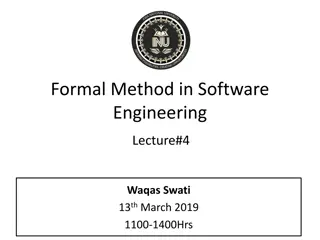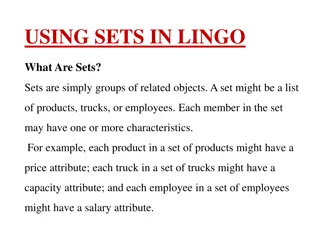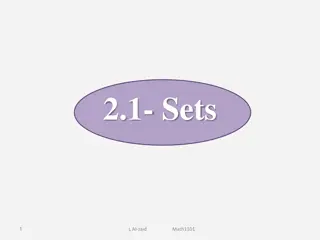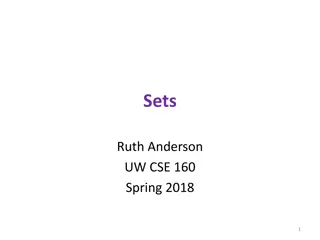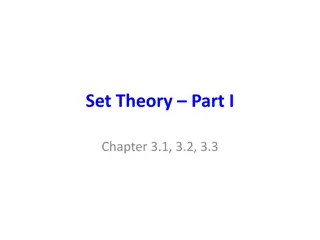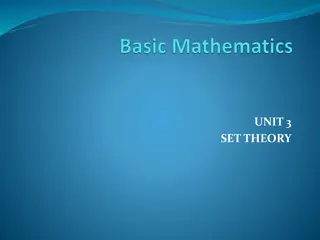Understanding Sets Theory Fundamentals
Sets in mathematics are unordered collections of objects, with elements referred to as members of the set. The concept includes defining sets, examples like vowels in the English alphabet and important sets such as natural numbers and rational numbers. It covers enumeration methods, set-builder notation, universal set, and the empty set. The notes touch on set relationships and differentiating the empty set from a set containing the empty set.
Download Presentation

Please find below an Image/Link to download the presentation.
The content on the website is provided AS IS for your information and personal use only. It may not be sold, licensed, or shared on other websites without obtaining consent from the author. Download presentation by click this link. If you encounter any issues during the download, it is possible that the publisher has removed the file from their server.
E N D
Presentation Transcript
A set is an unordered collection of objects. the students in this class the chairs in this room The objects in a set are called the elements, or members of the set. A set is said to contain its elements. The notation a A denotes that a is an element of the set A. If a is not a member of A, write. a A
Defining a Set Defining a set: enumeration or roster method S = {a,b,c,d} Order not important S = {a,b,c,d} same as {b,c,a,d} Listing more than once does not change the set. S = {a,b,c,d} same as {a,b,c,b,c,d}, Second form should not be used Elipses (...) may be used to describe a set without listing all of the members when the pattern is clear. S = {a,b,c,d, ......,z}
Examples Set of all vowels in the English alphabet: V = {a,e,i,o,u} Set of all odd positive integers less than 10: O = {1,3,5,7,9} Set of all positive integers less than 100: S = {1,2,3, ... ,99} Set of all integers less than 0: S = {...., -3,-2,-1}
Important sets N = natural numbers = {0,1,2,3....} Z = integers = {...,-3,-2,-1,0,1,2,3,...} Z+ = positive integers = {1,2,3,.....} Z>=0 = non-negative integers = {0,1,2,3,.....} R = set of real numbers R+ = set of positive real numbers Q = set of rational numbers
Defining a set: abstraction or Set-Builder notation Specify the property or properties that all members must satisfy: S = {x: x is a positive integer less than 100} O = {x | x is an odd positive integer less than 10} O = {x Z+ | x is odd and x < 10} Positive rational numbers: Q+ = {x | x = p/q, for some positive integers p,q}
Universal set, Empty set The universal set U is the set containing everything currently under consideration. Sometimes implicit: The content of U depends on the context. Example: When talking about numbers, often U=R or U=Q Sometimes explicitly stated. The empty set is the set with no elements. Shown by or {} symbols
Notes Sets can be elements of other sets { {1, 3}, {2, 4} } Empty set {} is not the same as the set containing the empty set {} not the same as { {} }
Set Equality Let A and B be sets. A and B are equal, denoted A=B, if A and B have exactly the same elements. More formally, A=B if for every x A, also x B, and for every y B, also y A.
Cardinality of a Set Cardinality of a set S, written |S|, is the number of elements in S |{3, 2, 6, 4}| = 4 |{ {}, {{}} }| = 2. (elements are {} and {{}}) |{}| = 0
Subsets B is a subset of A denoted by B A if for every y B also y A. A = B if and only if B A and A B {2, 4, 6, 8} {x Z+ | x is even} If B A and not A = B , B is a proper subset of A: B A {2, 4} {2, 4, 6, 8} {} is a subset of any set; For any set S, S S
Set Union Definition: Let A and B be sets. The union of the sets A and B, denoted by A B, is the set: {x | x A or x B} Example: What is {1,2,3} {3, 4, 5}? Solution: {1,2,3,4,5}
Set Intersection Definition: The intersection of sets A and B, denoted by A B, is {x | x A and x B} Example: What is {1,2,3,5} {3,4,5} ? Solution: {3,5} Note if the intersection is empty, then A and B are said to be disjoint.
Set Difference Definition: Let A and B be sets. The difference of A and B, denoted by A B, is the set containing the elements of A that are not in B. A B = {x | x A and x B} B A
Complement of a Set Definition: If A is a set, then the complement of the A (with respect _ to U), denoted by A is the set U - A U _ A A
Power Set of a Set Definition: The set of all subsets of a set A, denoted P(A), is called the power set of A. Example: If A = {a,b} then P(A) = { , {a},{b},{a,b}} P({}) = { {} } (or { } ) P({ {} }) = { {}, { {} } } or. { , { } }


